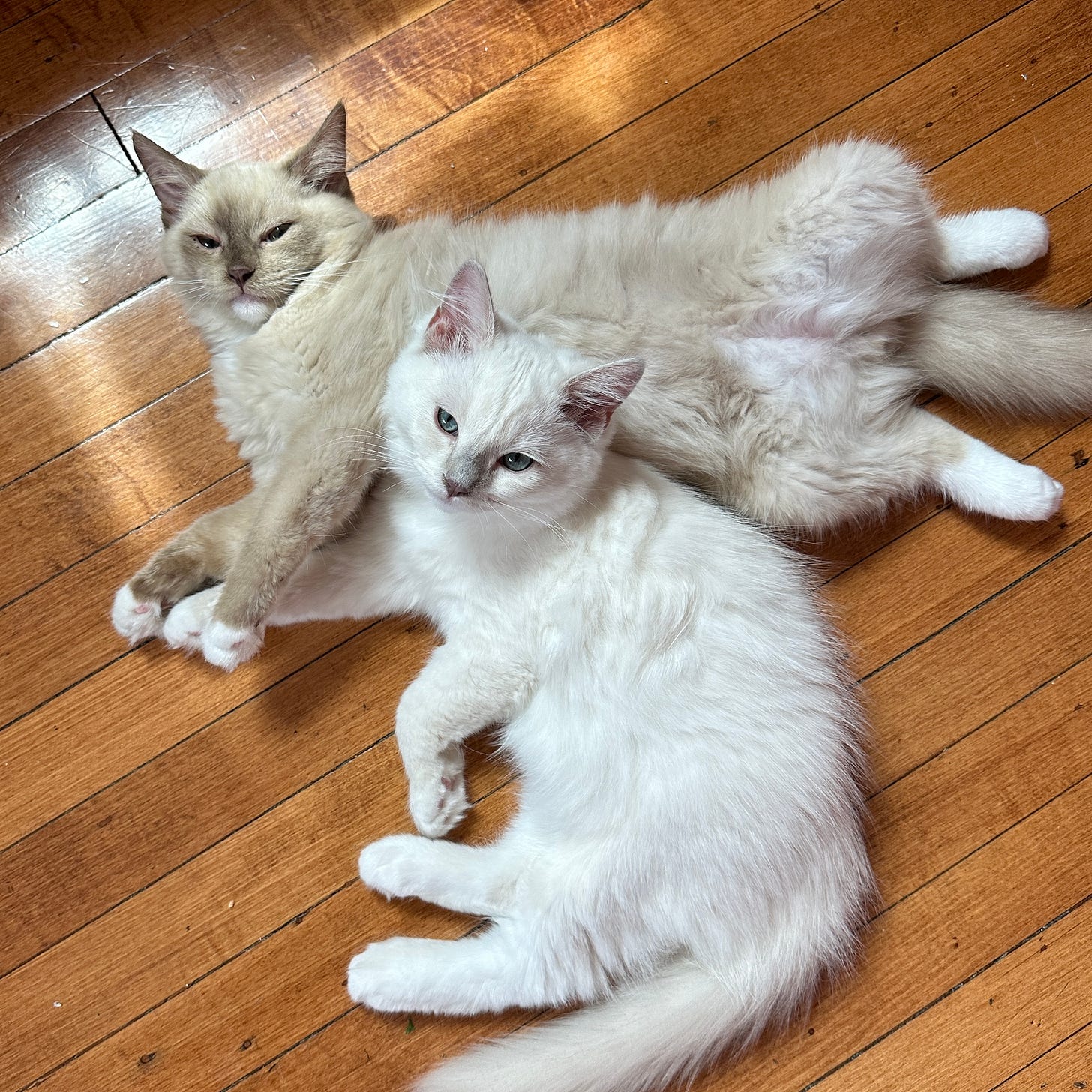When Towhee and Pipit were kittens, I made sure they had a few different litter boxes available on both levels of our home. Any cat behaviorist will tell you how important it is for cats to have multiple resources, including litter boxes, distributed around the home to combat stress and prevent problems—I wasn’t about to be a hypocrite. I didn’t want limited choices to cause them stress and strain their relationship, and I also wasn’t sure which box or location they’d prefer yet. I needed to learn about their preferences from them.
Over time, as they used their litter boxes reliably and without signs of conflict, demonstrated they were best friends rather than merely tolerant roommates,1 and almost exclusively used just one of boxes offered, I decided I could eliminate all boxes but their preferred choice. I only made an exception for when we had house guests. During these visits, I set up an extra box in a quieter area of our home so they wouldn't have to venture near guests to use their litter box. (Throughout my career, I've seen too many cats develop house-soiling issues simply because house guests made accessing the litter box too stressful). I made that one concession occasionally, otherwise Towhee and Pipit had only option for a litter box. They continued to use it reliably, showed no signs of conflict, and continued to be best friends. Everything seemed fine.
Amount of use ≠ importance
As I’ve been catching up on the research on how choice impacts animal welfare, I’ve come across some really interesting studies that demonstrate that having options matters to animals, even when they rarely utilize those options. Much of this work has been done with animals in zoo and farming environments, but lessons from them can be applied to how we care for the animals in our homes. For example, in one study investigating choice in polar bears, the bears showed fewer stereotypic behaviors and played more with each other when the door to their den was left open, compared to when it was closed off. These benefits were seen even though the polar bears only used their den 2% of the time! This finding suggests using the den wasn’t essential to them during those times, but having access to it was. In other words, they benefited from choice.
Another study investigated whether applying scents to toys given to kenneled dogs would increase toy use and decrease stress. While they found that dogs were more likely to play with the scented toys compared to the unscented toys, stress-related behaviors decreased and exploration increased when the dogs were exposed to the scents, regardless of how long they played with the toys or whether or not they played with them at all. Actively interacting with the scent wasn’t important—its mere presence provided the benefit.
Rarely used items can still be essential
These studies teach us an important lesson: we can't judge how valuable something is to our pets just by how often they use it. Pets have essential needs—like safe places to retreat and rest—that are crucial for their wellbeing even if they rarely use them. When these needs aren’t met, pets experience chronic stress and develop stress-related illnesses and behavioral issues. That's why examining the environment is, alongside a health assessment, the first step in addressing any behavioral challenge. And the great news is that improving the environment to better meet our pet’s needs is often the “low hanging fruit” of behavior change—these modifications are typically simple to implement, take much less time than training, are relatively inexpensive, and may cause only minor inconveniences to the humans in the household.
The benefits outweigh the costs
When I previously took away Towhee and Pipit’s second litter box, I did so because it was more convenient for me. We live in a small space and one of the few options for their second litter box was the middle of my closet—quiet and easily accessible for them, not so pleasant for me. It was a relief when I was finally able to enter my closet without stepping on stray bits of cat litter.
This time around I’m testing out my art studio/spare bedroom as location #2. It’s still quiet and accessible for them, a bit more pleasant for me. We’ll probably need to try a different spot soon, as they both tend to poop in this box whenever my husband or I are working nearby, but I’m committed to maintaining a second option for them despite the inconveniences. While I’m not sure if the previous lack of litter box options caused Towhee and Pipit stress (we hadn’t identified any issues before), I have noticed them playing more and grooming each other more since adding the second box. Whether that’s just a coincidence or signs of reduced stress, the evidence for the benefits of choice is too strong too ignore.
Are there any items (think beds, crates, perches, litter boxes) that you’ve taken away from your pet because they weren’t using them often? Are there any you might consider reintroducing after reading this?
Thanks so much for reading!
💜, Kelly
Insightful Animals is operated by me, Kelly C. Ballantyne, DVM, DACVB. I’m a vet behaviorist, nature fanatic, bird artist, wife, and mom to two hilarious Ragdoll cats, Pipit and Towhee. In my day-to-day, I consult directly with pet parents and veterinarians on a range of behavior problems in dogs and cats.
Cats demonstrate they are best friends (aka "preferred associates") by resting near each other and engaging in mutual grooming





